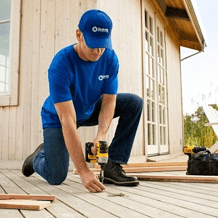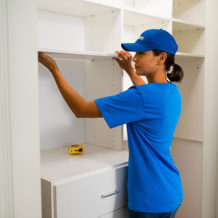Announcement
We offer a wide range of services for that fresh look, or just maintenance or updates to keep your home functioning and safe. Regardless of the size of the job, we have a craftsman that can tackle it. We offer a wide range of services for that fresh look, or just maintenance or updates to keep your home functioning and safe. Regardless of the size of the job, we have a craftsman that can tackle it.

Decks / March 14, 2023
Vaughan Deck Repair: How to Prevent Wood Rot on Your Deck

Wood rot is a common cause of Vaughan deck repair and replacement. If homeowners don’t learn how to prevent or stop it from spreading, they may spend nearly $2,000 or more to rebuild or restructure their decks. If caught early enough, wood rot is a minor issue, requiring little expense to repair. If homeowners neglect the sign of rot, they risk the structural integrity of their deck and possible injury from collapse.
Understanding Wood Rot
Microbes in the wood cause wood rot, which is a loss of cellulose materials that give wood its rigidity. The microbes digest the cellulose, breaking down the wood structure and weakening its integrity over time.
Not all wood damage or weakening results from microbes or the rot they inflict. Some damage can result from cracking, splintering, and other physical damage brought about by other natural and external forces.
That said, two types of rot inflict the most damage on decks: dry rot and wet rot. Both types of rot can affect larger areas of the deck than is visible. Many homeowners may believe their deck is okay because the surface appears intact, but microbes are hard at work digesting cellulose and destroying the material within the structure.
Dry Rot
Dry rot does not require a significant water source to thrive. It can also remain undetected for years, leaving the surface of the wood intact. Eventually, dry rot will appear on the surface. It will look like a fibrous and soft substance, similar to cotton. Once the fungus is visible, it has already caused significant damage to the wood. When on the surface, the substance is searching for more healthy wood to consume.
Wet Rot
Like dry rot, wet rot is a fungal infestation that requires moist conditions. The fungus responsible for wet rot is commonly known as a cellar fungus. Decks are most susceptible to rot when temperatures are between 4°C and 38°C. A deck with wet rot will have dark or light patches with soft, spongy areas. You might also notice a musty smell.
Learning Ways To Prevent the Spread of Rot
The only way to stop and contain the spread of wet or dry rot is to kill the fungus responsible for it. You can talk to a carpenter near me to learn more about rot prevention, but the primary means of prevention are moisture control and fungicide.
Determine the Cause
While it is challenging to determine the cause of dry rot, most occurrences of wet rot are obvious. You can often find a leak or drainage issue affecting the deck. If you cannot find the issue contact a professional to assess the situation. Determining the cause will help control the amount of rot and its spread.
Use Boric Acid
Because wood rot results from fungal infestations, a fungicide is necessary to control or eliminate the issue. Borate or boric acid is the most effective wood treatment. The beauty of this product is you can apply it during construction to reduce wood rot risks.
Repairing Rot
You can repair the damage from wood rot, but the approach is slightly different for wet and dry rot. Wet rot is not as invasive or fast spreading as dry rot, so you can typically replace the affected areas and rebuild them with wood putty if necessary. Dry rot, because it spreads quickly and within beams and boards, is more challenging to repair. Typically, you will need to remove any affected pieces and replace them.
Hiring Deck Repair Professionals
Are you noticing rot on your deck? Contact Handyman Connection to learn more about your deck repair options and work with a licensed, experienced decking professional.




